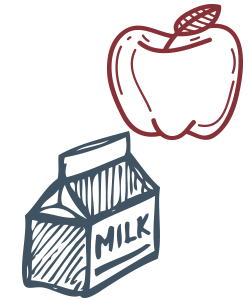

Exercise and Sleep
6 "Bests" About Kids' Exercise
At least one hour of physical activity a day helps kids to:
Feel less stressed
Feel better about themselves
Feel more ready to learn in school
Keep a healthy weight
Build sturdy muscles, bones, and joints
Sleep better at night
More time in front of the TV means less time playing and running. So parents should limit TV, video game time, and computer time. They should set a good example by being physically active themselves.
Exercising together can be fun for everyone. Some easy ways for kids to stay active include walking or biking to school, jumping rope, going to the playground, and participating in organized sports programs.
 Getting Enough ZZZZ's
Getting Enough ZZZZ's
Nodding off in school may not be the only outcome for otherwise healthy teens who don't get enough sleep. A study funded by the National Heart, Lung, and Blood Institute (NHLBI) links poor sleep in teens (ages 13 to 16 years old) to higher blood pressure.
Researchers found that teens who got less than 6 ½ hours sleep were 2½ times more likely to have elevated blood pressure than teens who slept longer. Also, teens who had trouble falling asleep or staying asleep were 3½ times more likely to have high blood pressure or pre-high blood pressure than teens who slept well. These results are similar to findings from other studies in adults. High blood pressure, if left untreated, can increase the risk of stroke and heart diseases later in life.
Sleep Facts: School-aged children and teens need at least nine hours of sleep a night. Adults need seven to eight hours of sleep a night.
Sleep Tips: Set a sleep schedule, going to bed and waking up the same times each day. Keep room temperature on the cool side. A TV or computer in the bedroom can be a distraction.
Breakfast & Lunch
 Remember that nutrition is an important factor in academic performance. Studies have shown that children who eat healthful, balanced breakfasts and lunches are more alert throughout the school day and earn higher grades than those who have an unhealthy diet.
Remember that nutrition is an important factor in academic performance. Studies have shown that children who eat healthful, balanced breakfasts and lunches are more alert throughout the school day and earn higher grades than those who have an unhealthy diet.
Making food choices for a healthy lifestyle for you and your child can be as simple as using these 10 tips. Use the ideas in this list to balance your calories, to choose foods to eat more often, and to cut back on foods to eat less often.
Balance Calories: Find out how many calories you need for a day as a first step in managing your weight. Go to www.ChooseMyPlate.gov to find your calorie level. Being physicall6y active also helps you balance calories.
Enjoy Your Food, But Eat Less: Take the time to fully enjoy your food as you eat it. Eating too fast or when your attention is elsewhere may lead to eating too many calories. Pay attention to hunger and fullness cues before, during, and after meals. Use them to recognize when to eat and when you've had enough.
Avoid Oversized Portions: Use a smaller plate, bowl, and glass. Portion out foods before you eat. When eating out, choose a smaller size option, share a dish, or take home part of your meal.
Foods to Eat More Often: Eat more vegetables, fruits, whole grains, and fat-free or 1% milk and dairy products. These foods have the nutrients you need for health—including potassium, calcium, vitamin D, and fiber. Make them the basis for meals and snacks.
Make Half Your Plate Fruits and Vegetables: Choose red, orange, and dark-green vegetables like tomatoes, sweet potatoes, and broccoli, along with other vegetables for your meals. Add fruit to meals as part of main or side dishes or as dessert.
Switch to Fat-Free or Low-Fat (1%) Milk: They have the same amount of calcium and other essential nutrients as whole milk, but fewer calories and less saturated fat.
Make Half Your Grains Whole Grains: To eat more whole grains, substitute a whole-grain product for a refined product—such as eating whole-wheat bread instead of white bread or brown rice instead of white rice.
Foods to Eat Less Often: Cut back on foods high in solid fats, added sugars, and salt. They include cakes, cookies, ice cream, candies, sweetened drinks, pizza, and fatty meats like ribs, sausages, bacon, and hot dogs. Use these foods as occasional treats, not everyday foods.
Compare Sodium in Foods: Use the Nutrition Facts label to choose lower sodium versions of foods like soup, bread, and frozen meals. Select canned foods labeled "low sodium," "reduced sodium," or "no salt added."
Drink Water Instead of Sugary Drinks: Cut calories by drinking water or unsweetened beverages. Soda, energy drinks, and sports drinks are a major source of added sugar, and calories, in American diets.
Article Source:
http://www.nlm.nih.gov/medlineplus/magazine/issues/fall13/articles/fall13pg20.html
Image Source: http://simplecentsblog.org/first-day-of-school.html